Northeast Nominee: Dave & Jenny Stoner of Vermont
What makes them outstanding?
The Stoner Tree Farm is a
wonderful example of how an abandoned subsistence farm can be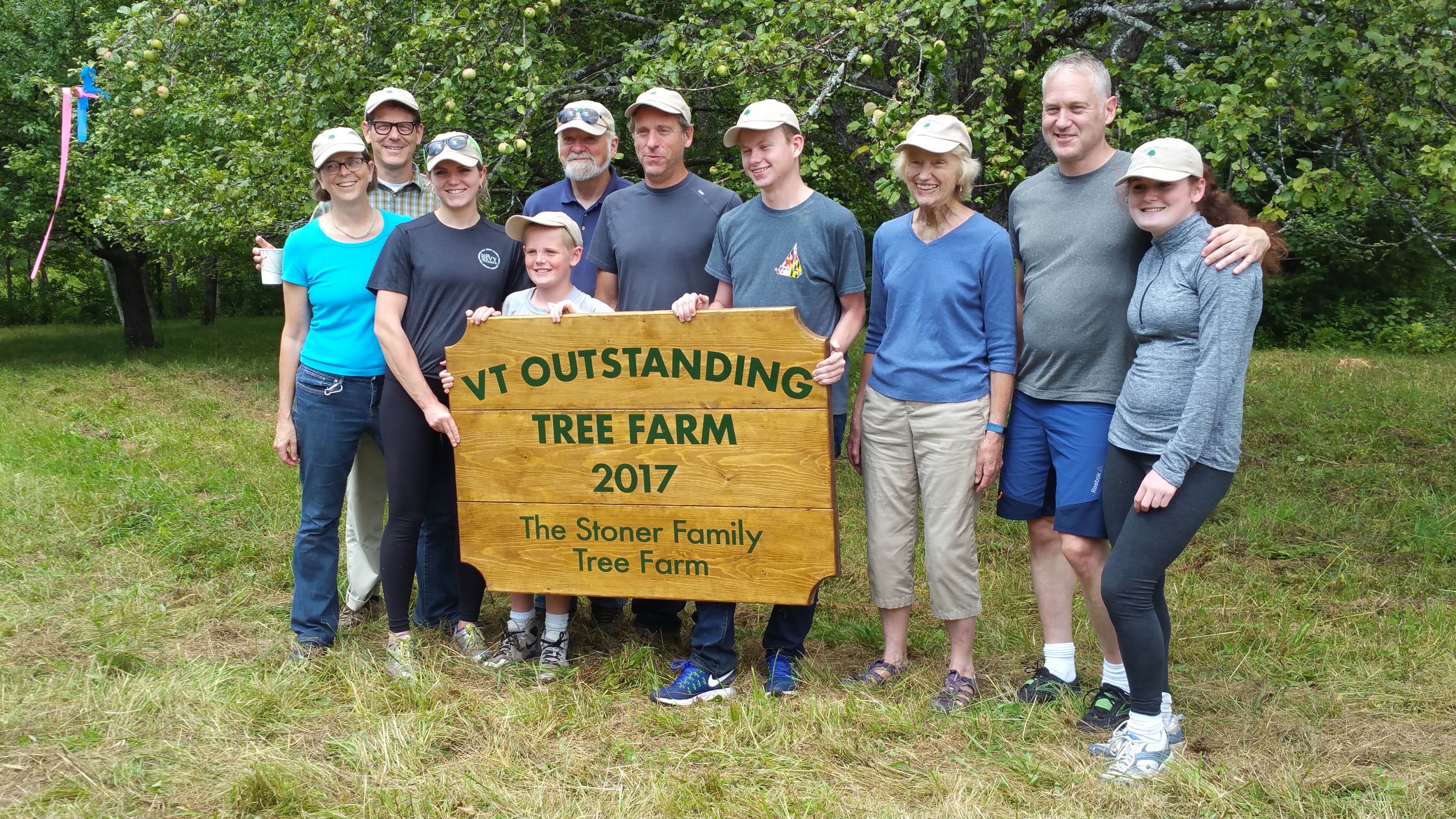 transformed into
a well-managed resource for family, community, and wildlife. With the assistance of dedicated foresters,
inspired environmental educators, a skilled professional logger, State and
Federal environmental experts, and hard work by Dave and his family, a tree
farm has been created that epitomizes the mission and goals of the Tree Farm
community. The work on this 360-acre
property over the past 35 years has recognized the needs of the natural
communities, the wildlife, and humans by taking compatible actions that enhance
all three requirements while fulfilling the four mission goals of the Tree Farm
Program. Serving these multiple needs
and goals is the primary motivation that inspires the management and work
activities of three generations of the Stoner Family. Beyond the exemplary on the ground
management, the work of the Stoner Family transcends the immediate impacts in
the woods, and is witnessed and experienced by the hundreds of visitors to this
land each year. Whether it is through
planned community events on the land, or indirect visitation by recreators
using the established trail system through the property, visitors experience first-hand
the true value of stewardship through seeing the efforts of the Stoner family
in the woods.
transformed into
a well-managed resource for family, community, and wildlife. With the assistance of dedicated foresters,
inspired environmental educators, a skilled professional logger, State and
Federal environmental experts, and hard work by Dave and his family, a tree
farm has been created that epitomizes the mission and goals of the Tree Farm
community. The work on this 360-acre
property over the past 35 years has recognized the needs of the natural
communities, the wildlife, and humans by taking compatible actions that enhance
all three requirements while fulfilling the four mission goals of the Tree Farm
Program. Serving these multiple needs
and goals is the primary motivation that inspires the management and work
activities of three generations of the Stoner Family. Beyond the exemplary on the ground
management, the work of the Stoner Family transcends the immediate impacts in
the woods, and is witnessed and experienced by the hundreds of visitors to this
land each year. Whether it is through
planned community events on the land, or indirect visitation by recreators
using the established trail system through the property, visitors experience first-hand
the true value of stewardship through seeing the efforts of the Stoner family
in the woods.
Tree Farmer story
In our family, this property is fondly referred to as The Woodlot. We are three generations of people who love these woods and take great pride in the conversion of the two subsistence hill farms into the Certified Tree Farm that has been bestowed the honor of Vermont Tree Farm of the Year 2017.
The progress on this land over the past three decades has not been solely through our family efforts. The description of what has taken place brings to mind a walk in woods where we find a turtle sitting on a waist high tree stump. It is certain that the turtle did not climb the stump all by itself. A perfect example of the fact that it has taken many helping hands to achieve our progress.
Our land is located in Greensboro, Orleans County, the home of the world’s best brewery and a center for world award-winning craft cheeses. However, our home is in Craftsbury, the town just north of Greensboro. Craftsbury is best known for the Outdoor Center and its excellence in the sports of rowing and cross-country skiing sending three athletes to last winter’s Olympics.
We have the good fortune of living next door to Sterling College, one of Vermont’s premier colleges in stewardship education. We are within walking distance of most of Sterling’s professors, the Orleans County Forester, a former VT Commissioner of Fish and Wildlife, the former Executive Director of Vermont Coverts, the current Director of VT Lakes and Ponds, the former Deputy Commissioner of the VT Department of Agriculture, and a number of long-time farmers and wildlife enthusiasts who are willing to share their knowledge and experience. We live in what is truly paradise for aspiring woodlot managers.
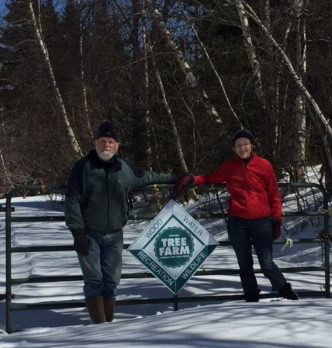 The property is a combination
of what historically were two subsistence hill farms. The local historical
society gave us an early 1900 picture of one of the homesteads that shows three
buildings on a land that is devoid of trees.
The three stone foundations are all that remain of those buildings that
today are totally surrounded by trees a clear example of nature at work.
The property is a combination
of what historically were two subsistence hill farms. The local historical
society gave us an early 1900 picture of one of the homesteads that shows three
buildings on a land that is devoid of trees.
The three stone foundations are all that remain of those buildings that
today are totally surrounded by trees a clear example of nature at work.
We purchased the land in 1983 when we were living in England. The next summer we attended a 3-day workshop at Sterling College for woodlot managers taught by Ross Morgan, a local consulting forester and the recent recipient of the Forest Stewards Guild Award for Lifetime Achievement. Ross got us started on a path of silviculture that has taken a firewood collecting hobby into the managed forest that has captured the hearts and minds of three generations of our family.
The property is primarily a northwest facing hill covered mostly in sugar maple with some beech and yellow birch that turns into balsam fir and spruce with pockets of paper birch and northern white cedar at the lower levels. Early on in our journey as stewards, we made several two-acre patch cuts which are now populated with pioneer species. The open fields are either the remnant of a Christmas tree farm or the primary location of wild apple trees. The land has many springs that contribute to both north and south running watersheds in northern Vermont. When different grandchildren have explored the woodlot with the consulting forester, the discovery of a spring has resulted in the forester naming the spring for the grandchild.
We participated in the NRCS WHIP program for ten years and this started us on the path of enhancing wildlife habitat across the woodlot through clearing and pruning the beech and wild apple trees. We continue to prune the apple trees and discover more as we concentrate clearing on the borders of the open fields. We now count more than 300 wild apple trees in the annual pruning ritual and there are many more to add in the future. Our wildlife camera, tracks, and scat have helped us identify a multitude of animal life enjoying the property. We also learned to be careful in brush hogging the open fields postponing the work until late summer, after the bird nesting season. An action that also continues to provide tall grass for the does to hide their young fawn until the fawns are able to maneuver on their own.
However, all has not been perfect. A few years ago, the ridge line sugar maples were infested with the saddled prominent caterpillar and the following year the maple leaf skeletonizer. We have made several patch cuts in the sugar bush in an attempt to generate new growth. Some of the patch cuts have been taken over by hay scented fern that keeps the seed of the young trees from germinating but others are showing signs of aggressive regeneration.
Under Ross Morgan’s guidance
we have carried out both personal and professional logging projects in the 35
years we have been the stewards of the land.
Our first softwood and hardwood thinning was in 1995. A major project in 2000 provided 65,000 board
feet of marketable wood and we kept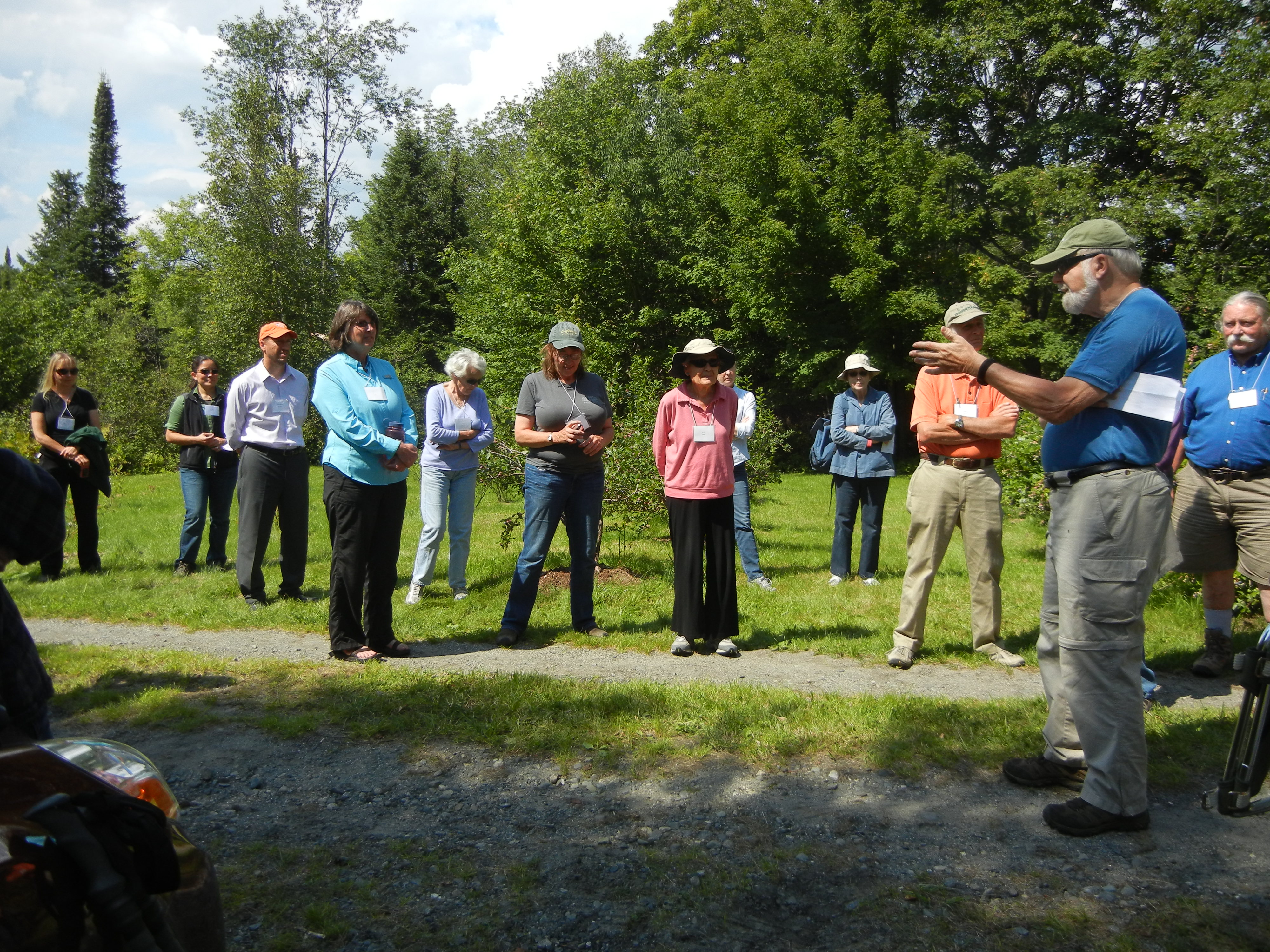 enough spruce to mill on site and build an
equipment shed, the only structure on the land, where all of our tools to manage
the woodlot are housed. The WHIP funded patch cuts started in 2005 and
concluded in 2014. Stove wood and
firewood has been harvested annually from the freeing up of the wild apple
trees.
enough spruce to mill on site and build an
equipment shed, the only structure on the land, where all of our tools to manage
the woodlot are housed. The WHIP funded patch cuts started in 2005 and
concluded in 2014. Stove wood and
firewood has been harvested annually from the freeing up of the wild apple
trees.
Our management planning has now been transferred to the extremely capable hands of Rick Morrill and Dawn Morgan, of Northern Forest Conservation Services. They are two younger scientists who have brought exceptional knowledge, wonderful skills, and formidable leadership to the forestry community. We are most fortunate that they have moved to northern Vermont after many years of successful forest management in Maine and national leadership of the Forest Stewards Guild. Their work along with the superb educational guidance of the Orleans County Forester, Jared Nunery, means we have the best possible team to work with the succeeding generations of our family in the management of this Tree Farm.
For the following areas describe how the landowner's management addresses it
Wood: Silviculture is the guiding practice that has directed all management efforts over the last three decades on our woodlot, and we are currently on our third ten-year management plan. The dominant varieties are sugar maple, yellow birch, balsam fir, spruce, and cedar with notable presence of beech, ash, cherry, and aspen. Since owning the property, we have had two commercial harvests of hardwood and softwood. Some of the softwood harvest provided the logs that were milled on the land to produce boards used to build the equipment shed. Several cords of firewood are produced annually by freeing up of the wild apple and beech trees and periodic thinning in the 90-acre sugarbush.
One neighbor will use some wood from the apple trees to smoke his crop of rye that will be used for distilling rye whisky. Another neighbor supplements his commercial organic apple orchard with our wild apples in experimenting in formula development for making hard cider. Bill Lee, the former Hall of Fame Red Sox pitcher, has used the harvested sugar maple to make baseball bats one of which, we are told, has turned up in the Baseball Hall of Fame.
The youngsters in our church earned some of their money for a trip to Iona by stacking brush and hauling logs from our patch cuts, and grandchildren have spent many hours splitting, stacking, and distributing firewood.
Our logger made seven
substantial patch cuts in the sugarbush that was damaged by successive years of
caterpillar infestation. Regeneration of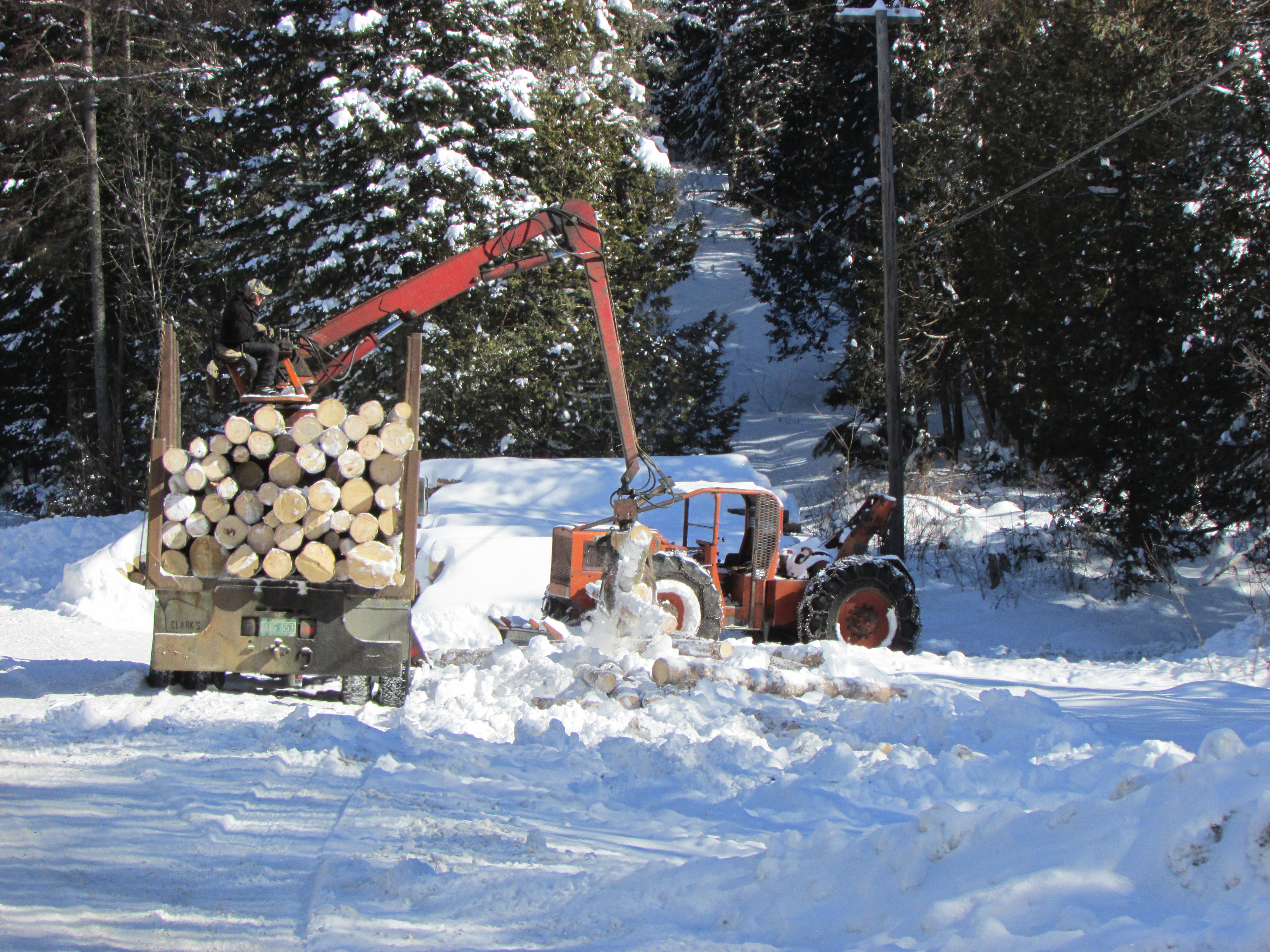 the sugar maple in these cuts is partially successful with numerous new trees
in some, while in others growth has been restricted by the matting of hay
scented fern, an issue we continue to monitor to ensure successful regeneration
eventually occupies all treatment areas.
the sugar maple in these cuts is partially successful with numerous new trees
in some, while in others growth has been restricted by the matting of hay
scented fern, an issue we continue to monitor to ensure successful regeneration
eventually occupies all treatment areas.
Water: We moved to Vermont in 1996 and our pond was built in 1998. It is now a well-used resource for community activities, recreation, meditation, and enjoyment of nature.
The many springs on the land provide the source of water for the trout pond and the beginning of two streams one flowing south into Caspian Lake, then into the Lamoille River, and eventually into Lake Champlain. Several springs flow into a beaver pond and resulting swampy area that is the beginning of Whetstone Brook, a stream that joins the Black River and eventually flows north into Lake Memphremagog. So, the property is a contributor to two of the three major watersheds of Vermont’s Northeast Kingdom.
In order to keep our grandchildren interested in the tree farm, our consulting forester Ross Morgan has named the main springs for our grandchildren whom he has taken into the woods for exploratory walks. Today, Caroline, Gideon, Clare, and Ryan all have springs named for them and the other three boys are anxious to explore the woods for their namesake springs
Under the supervision of the Vermont State experts, we have added culverts, ditching, stone dams, and waterbars to prevent sediment from entering streams and control erosion. This project has been used to demonstrate the best practices to minimize erosion and control sediment in accordance with recently revised Acceptable Management Practices for Maintaining water quality on Logging Jobs in Vermont. In 2017, this work was included in a public tour to raise landowner awareness of revised statewide water quality standards for forestry practices.
The many springs are kept clean and a fresh water drinking system has been engineered for one spring as a source of refreshment to hikers. There is no greater way to connect with land than by drinking directly from a fresh forest spring.
Wildlife including threatened and endangered species: This land is a natural rest stop on the north/south corridor that provides the path for wildlife migration in the northeastern portion of the United States. The area is nestled in a critical linkage point between two larger blocks of contiguous, unfragmented forest recently identified as priority habitat conservation areas by the State of Vermont and The Nature Conservancy through the Staying Connected Initiative (see: http://stayingconnectedinitiative.org/our-places/worcesters-to-nek/).
Careful and timely brush hogging produces browsing material for the wildlife while protecting the nesting habitat of ground birds and the hiding of newly born fawns in the spring. Multiple patch cuts have regenerated pioneer species of trees that are natural browsing material for a multitude of wildlife. The pond is home to trout that are stocked every two or three years and they are greeted by other varieties of fish provided by natural transfer to the pond by the blue heron and ducks. Salamanders, frogs, and toads have made homes on and around the pond as well as in the wetland area that forms the headwaters of Whetstone Brook.
Mast development has been
enhanced through releasing beech trees, and markings on the trees show recent
signs of the presence of black bear. The
release of wild apple trees is a continuous and annual project to provide
sunlight and remove the competition from ground cover. The annual pruning includes more than 300
wild apple trees with additional areas added to the project each winter.
and annual project to provide
sunlight and remove the competition from ground cover. The annual pruning includes more than 300
wild apple trees with additional areas added to the project each winter.
A great variety of wildlife has been observed on the land white tail deer, black bear, moose, wild turkey, grouse, owls, porcupine, snowshoe rabbit, fox, voles, coyote, racoon, skunk, fisher cat, bob cat, etc. The periodic count of song birds has identified more than 30 species who inhabit the woods and open fields, including the rare Canada Warbler.
Recreation and Aesthetics including special sites: Groomed ski trails run through the entire property. These trails are maintained by the Craftsbury Outdoor Center as a part of its Network connecting Greensboro and Craftsbury. The skiing is open to all as are the hiking trails that supplement the groomed trails. Each winter, hundreds of skiers pass thru the woodlot, offering a chance for many users to experience firsthand the value of the application of silviculture and long-term stewardship through the Tree Farm Program.
The Greensboro Ladies Walking Society plans periodic hikes on the land during the summer month. The local Presbyterian Church holds its annual corn roast at the pond every fall. Several neighbors ride their horses on the trails, and the pond is a popular local swimming location during hot weather.
Neighbors and friends enjoy the blueberry and apple harvest seasons, and the garlic patch has provided starter cloves for many gardeners and farmers in the area.
Special events are frequently hosted on the land. Recent events include camping, picnics, fruit harvest, a wedding, and a memorial service for a neighbor who used the pond as a site for meditation. The Stoner family recognizes the many values of the land, and the great indirect value of exposing recreators to stewardship through the Tree Farm program and their management practices in the forest.


